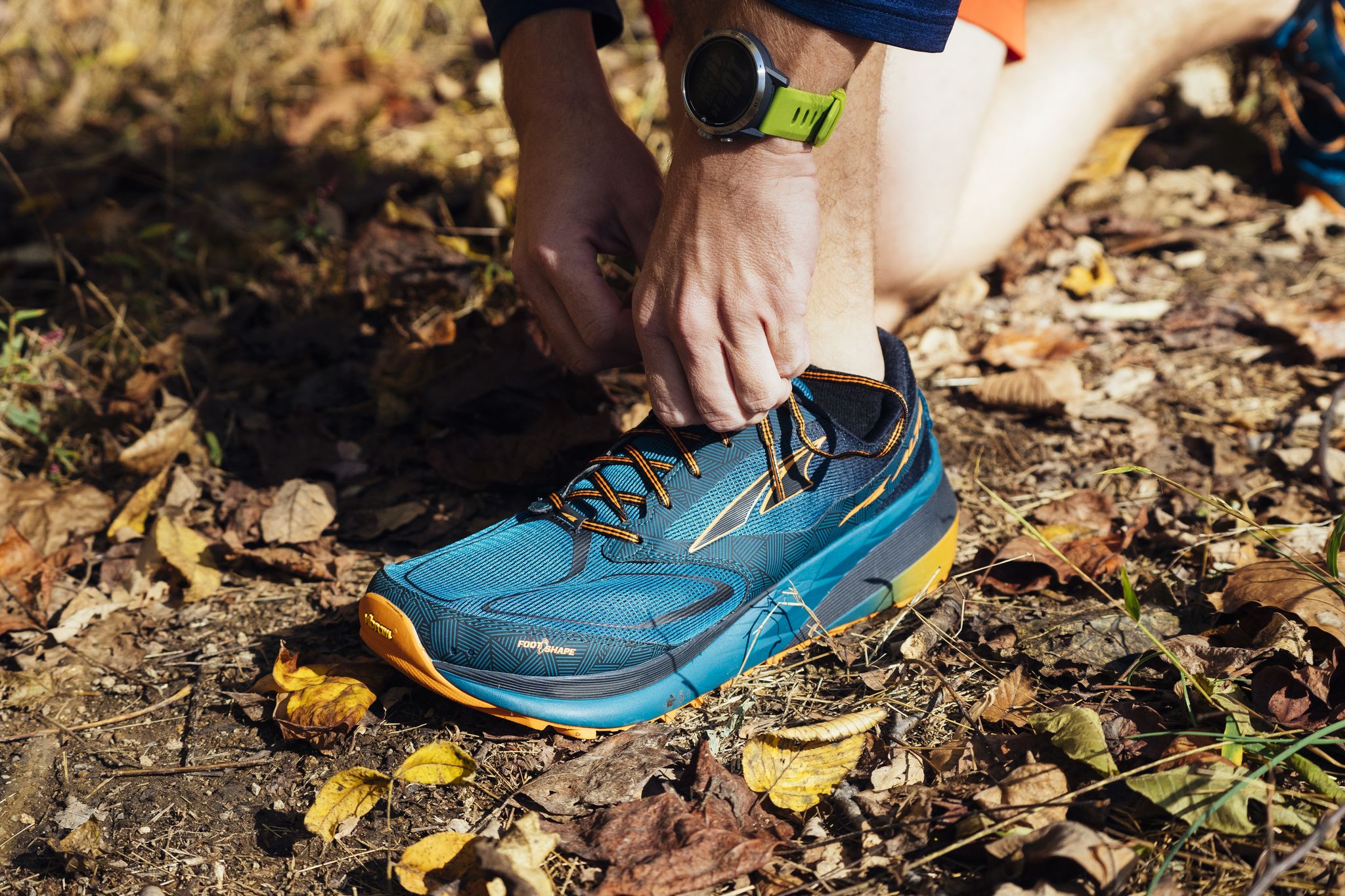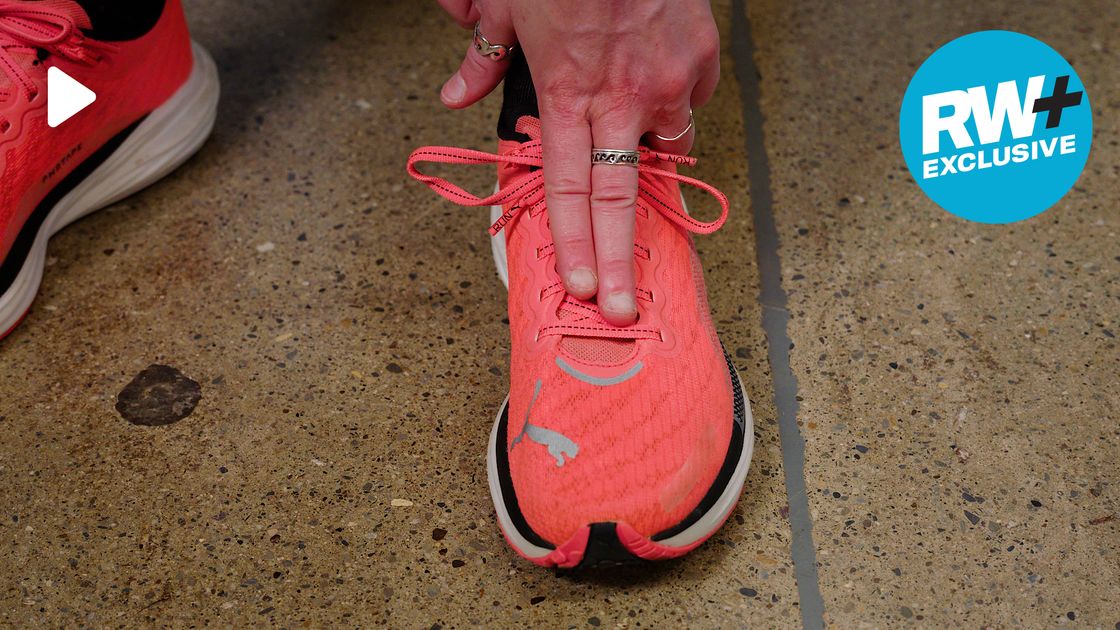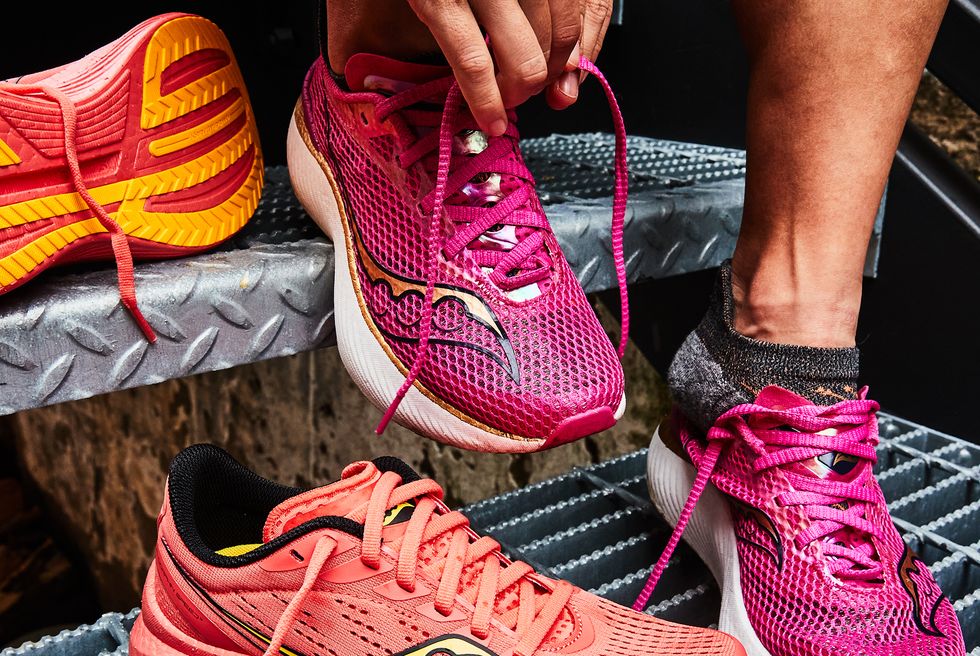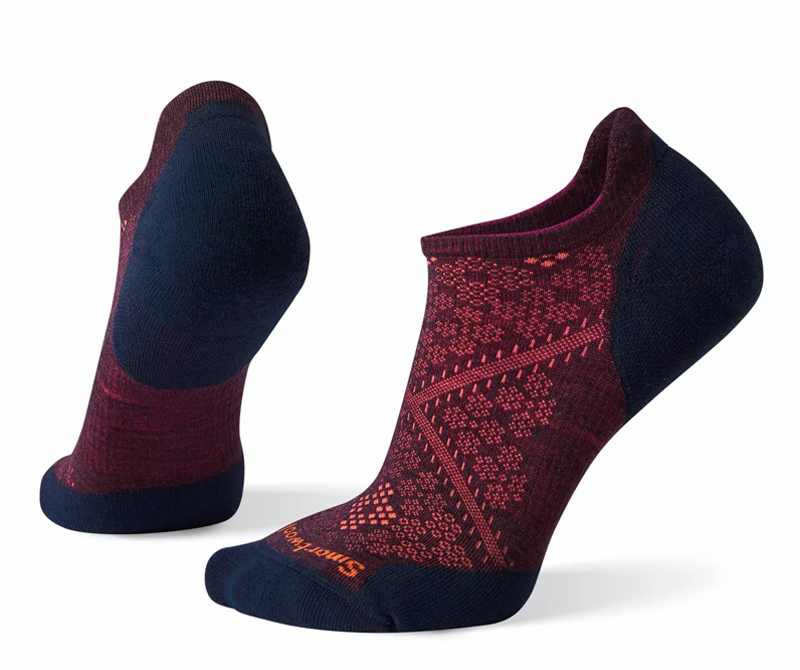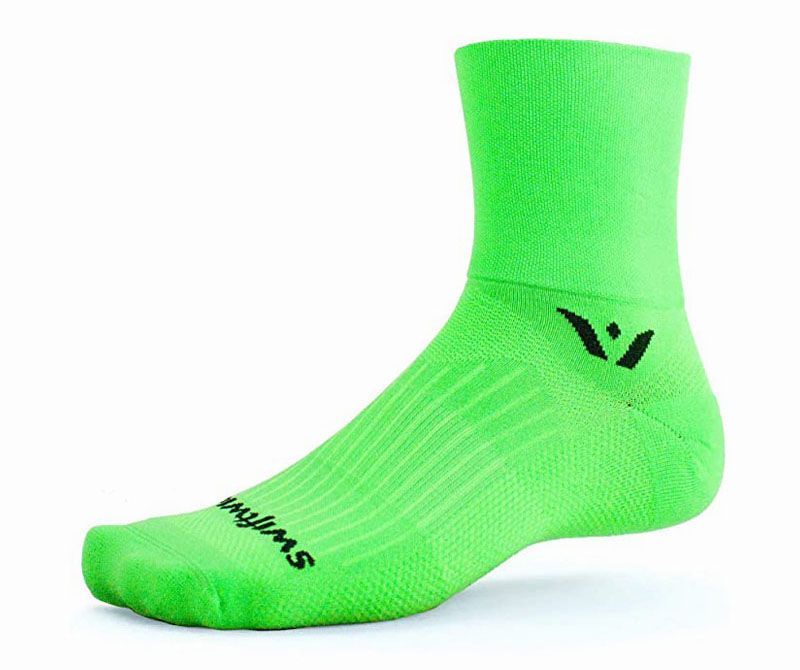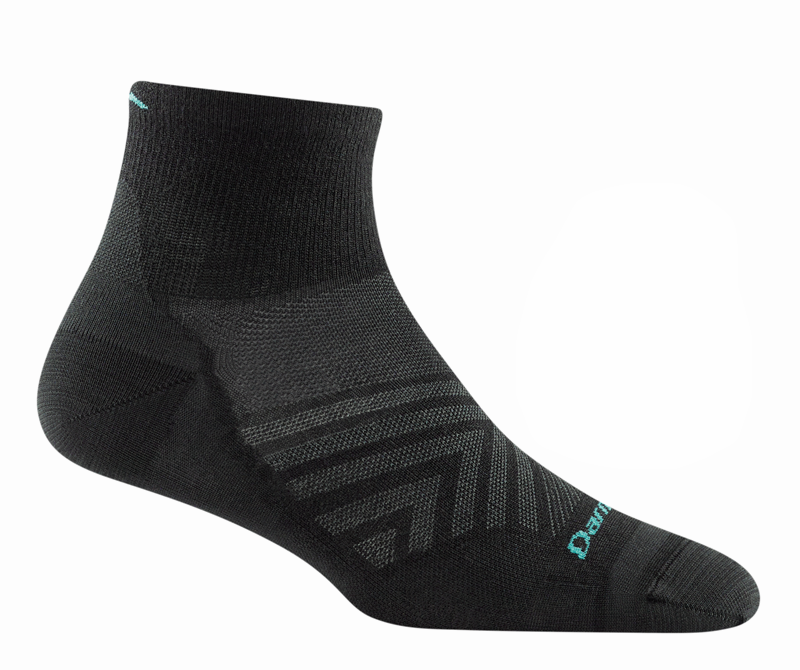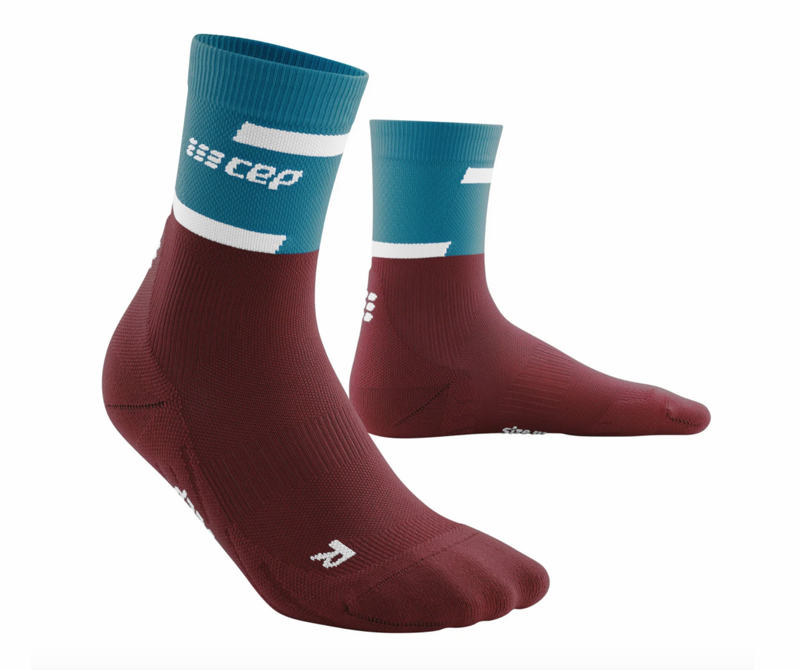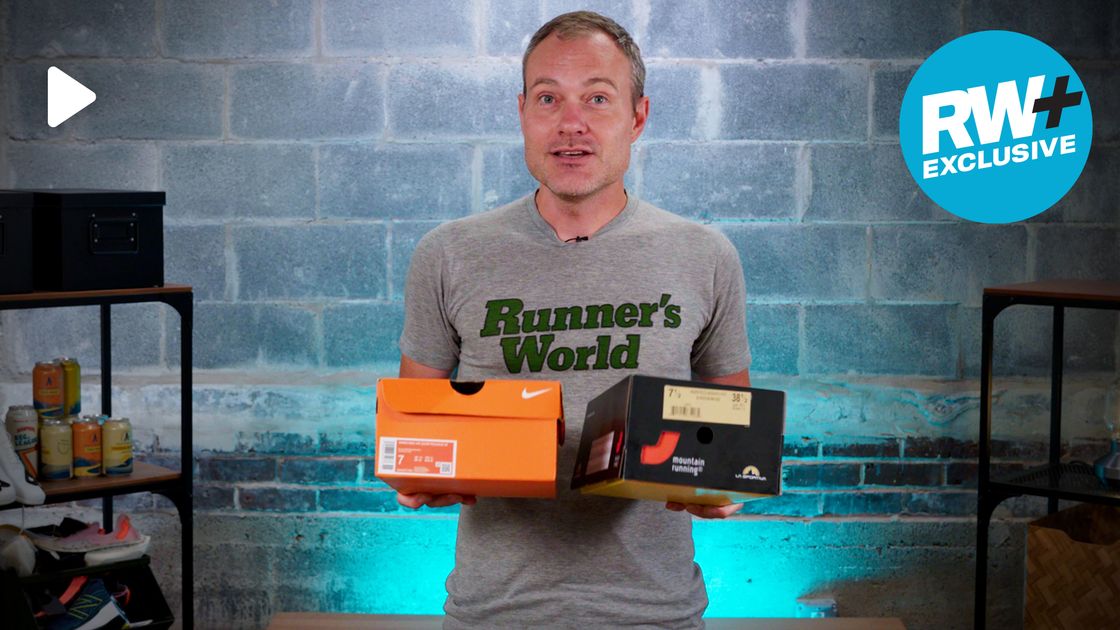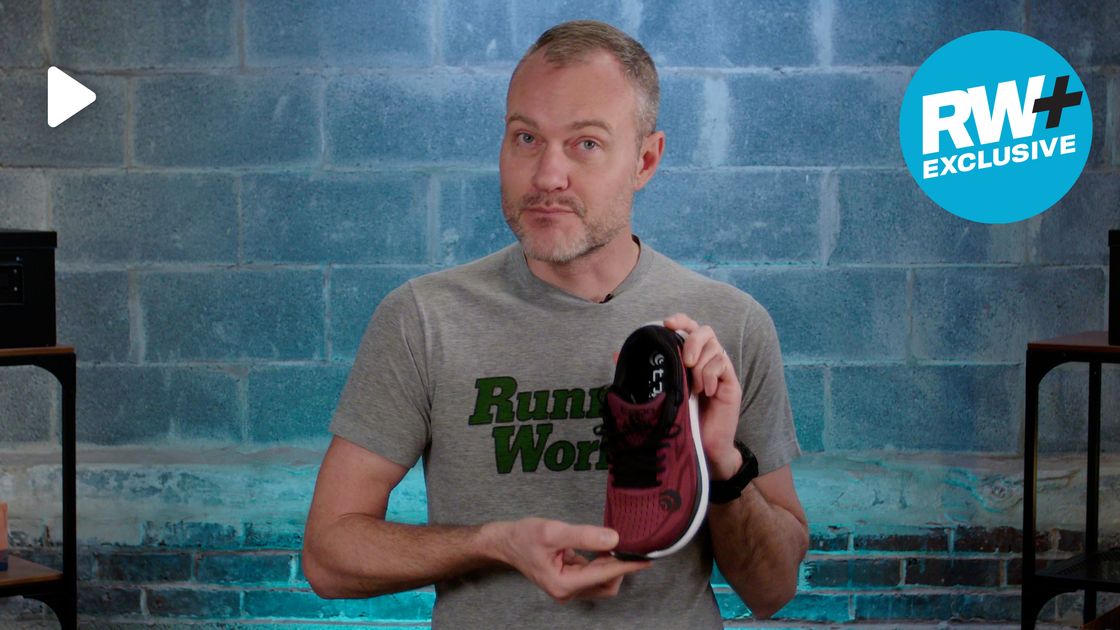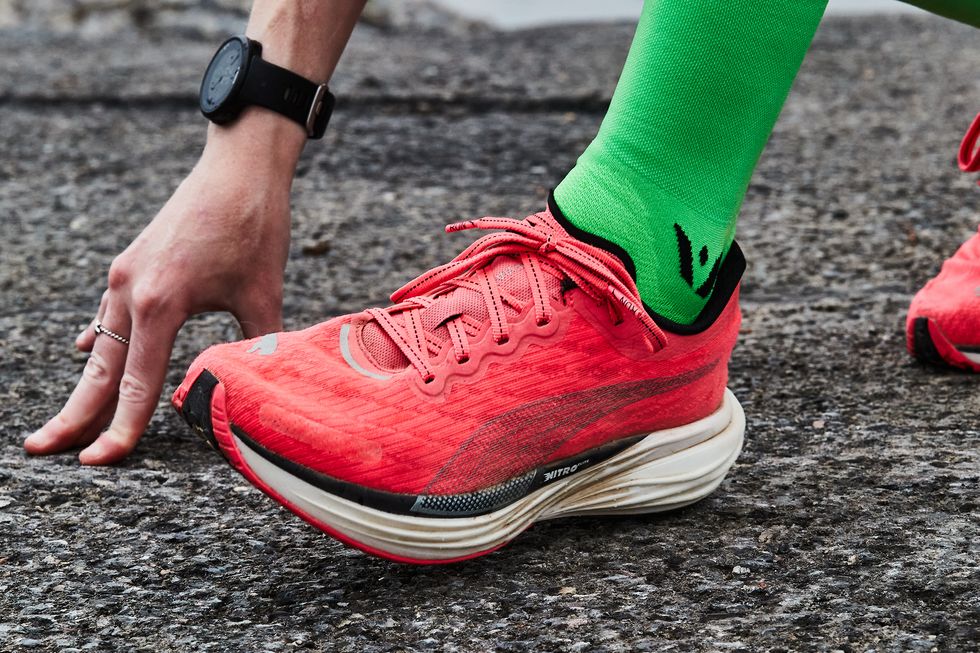Zero-drop, carbon-fiber plates, minimalist or maximalist—runners love to discuss and debate the latest shoe types and features.
Far fewer long-run chats and online forums are dedicated to discussing the fit of your running shoes. But, it’s important to make sure you’re wearing the correct size, and if you’re not, you’ll need to know how to find the best fit. Why? How well your running shoes match the length, width, and shape of your feet may actually matter as much as—if not more than—the cushioning that goes underneath them, says Geoffrey Gray, D.P.T., founder and director of research at Heeluxe.
Conventional wisdom holds that your running shoes should be about a size bigger than your dress or casual size. There’s a grain of truth to that—increased blood flow and swelling during and after exercise do make your feet expand, so your running shoes tend to be larger. However, because of sizing variations in all types of shoes, there are too many variables to know exactly how the numbers will align, says Kevin Vincent, M.D., Ph.D., the department chair of Physical Medicine and Rehabilitation at the University of Florida and director of the UF Running Medicine Clinic.
So how do you determine how your shoes should fit? Try these steps:
Step 1: Line the Insole up With Your Foot
Take the insole (or sockliner) out of the shoe and stand on it. The size and shape should match the size and shape of your foot, Vincent says. Your toes shouldn’t spill over the front or sides, and the tip should come to a point roughly where your toes narrow.
Step 2: Assess Lace Tightness
Put the insole back in and put the shoes on. Lace them tightly enough to lock the shoe over your navicular bone—the bony bump over the high point of your arch—or instep, Gray says, but not so tightly that you constrict nerves and blood vessels. You should be able to slide a finger between the knot and your shoe, Vincent says.
Step 3: Check Your Toes
Stand up and check the feel and fit. You want about a thumbnail’s worth of width between your longest toe and the front of the shoe, keeping in mind that your longest toe may be your second metatarsal (the heads of the long toe bones) and not your big toe. As for width, check that there’s little to no pressure on your pinky toe and only slight pressure on your big toe—slightly looser than the snugness of a watch strap on your wrist, Gray says.
Step 4: Walk and Run
Walk—and, preferably, run. Check that your heel doesn’t slip and that nothing pinches or rubs uncomfortably against your ankle. Also, check the fabric of the upper—if it gathers or bunches you might need a snugger fit, and if it bulges or stretches, you might need to go bigger, says Allison Bowersock, Ph.D., an exercise physiologist and co-owner of RunAbout Sports, a specialty running-shoe store in Roanoke, Virginia.
Step 5: Repeat, as Needed
Don’t settle for something cramped thinking you’ll break them in; your running shoes should fit properly right from the start, Vincent says. While some parts of the shoe—including the midsole and cushioning—may change for the better with mild wear, that doesn’t affect the sizing or fit, Gray says.
Still have questions? No worries. In the video below, we take you on a virtual shoe fitting and share more helpful tips.
Gray’s company has tested hundreds of runners and now works with about 50 footwear brands, using research to help them improve their products. The better a shoe fits, the more comfortable runners will feel wearing it, he says. Not only does this make your miles more pleasant, some research suggests comfort plays a role in injury risk.
“From a kinetic chain standpoint, your foot is the first point of contact with the ground; your whole skeletal structure is supported by your feet,” says Bowersock.
Can Your Shoe Size Change?
Start with some hard data: If you haven’t had your feet measured since your parents dragged you for school shoes, go for a fitting. The length and width of your feet change because of factors like aging, injuries, and pregnancy.
“The size you wear when you’re 18 might not be the same size you wear when you’re 42, just like you’re probably not wearing the same size pants,” Gray says. “And that’s okay. But we need to get those measurements to know how to change it.” In fact, he recommends getting measured once a year.
Need More Help? Get Fitted by a Pro
Ideally, you’d have your feet measured and fitted for shoes at a local running-shoe store. People who’ve bought their shoes from a brick-and-mortar establishment seem less prone to poor fit than those who shop online, Gray says.
For one thing, trained salespeople have a feel for which brands run large or small and in which ways. Plus, trying on the shoe is the only way for you to know how comfortable it is. Go later in the day or after a run, when your feet are more swollen, Vincent says.
What to Do if Your Feet Are Different Sizes
At RunAbout Sports, the fitting process starts with measuring both feet while you’re standing up. That’s important, because there can be as much as full size-worth of difference between your right and left, Bowersock says. You’ll want a shoe that fits the bigger foot. (You can always change the lacing or add an extra sock on the smaller foot, Vincent says—or, if it’s due to a foot problem like a bunion you haven’t had treatment for, consult with a podiatrist.) Ideally, a salesperson will bring you several different options. They’ll run through a similar assessment to the one mentioned earlier to find the right fit for you.
How Much Wiggle Room Do You Really Need?
There are exceptions to the rule of needing a thumb’s width of space between your longest toe and the front of your running shoe. For instance, the reason you need extra room in the toes is because most shoes are designed to flex when you run, especially uphill—and that motion brings your toes closer to the end of the shoe. But models with carbon-fiber plates lack this motion, so they can fit more snugly.
“If you’re buying a shoe with different features than what you might be used to—like going from like a trail-running shoe to a major backpacking shoe, or a normal racing flat to a carbon fiber-equipped racing flat—your best size might be different,” Gray says.
Don’t stress if your speciality shop lacks advanced technology, such as foot scanners or fit systems. While they can offer a good baseline for understanding your feet and help standardize the fit process across stores, they’re not yet a substitute for a good shoe-fitter and shouldn’t supersede your experience of how a shoe feels, Gray says.
Pro Tip: Socks Affect Your Size
When buying shoes, runners often overlook one important detail: their running socks. Thick fabric can require you to go up as much as a full shoe size to accommodate, Gray says. A thinner pair of socks can provide some wiggle room, if you need it. This can be especially helpful to remember in the summer when your feet tend to swell a bit more in the heat. Try to stick to the same type of socks for each run, and wear them to the store for your fitting. If weather doesn’t permit total consistency—say, you want thicker socks to survive a frigid winter—you might need a different size shoe for each season. “It makes a world of difference,” Gray says.
Signs Your Running Shoes Don’t Fit Well
Wear shoes that are too short, and your toes can butt up against the front. This contributes to the bane of runners’ existence, black and missing toenails, says Vincent. This contact can also damage toe ligaments and the metatarsals, leading to deformities like hammer toes, he says. Over time, you can also develop Freiberg’s infraction—a stress fracture of the second metatarsal—from repeated impact. Plus, squeezing your toes together too tightly forces the muscles of your foot out of alignment, Gray says. As a result, you might feel foot fatigue and develop pain in your arches.
At the front of your ankle, there’s a bundle of nerves, tendons, and blood vessels, Vincent says. They’re secured by a tight band of tissue, but shoes that fit too snugly can compress them, causing pain on the top of your foot or numbness and tingling throughout them.
Going too big, meanwhile, means your foot shifts around in your shoe. If a shoe doesn’t lock down over your navicular bone, your foot can move back and forth with each step. The shear stress of shifting shoes and bunching socks against skin creates blisters, Vincent says. Plus, you can also wind up with bruised toes and toenails this way as your foot bangs into the front of the shoe with each slide, Gray says.
Finally, if you’re wearing stability shoes that have a supportive medial post, getting the sizing wrong in either direction can alter where it falls on your instep. You may inadvertently put pressure on your plantar nerves, which run across the bottom of your feet, Vincent says. Constriction there can cause numbness, tingling, and pain on the bottom of your foot that can mimic conditions like plantar fasciitis.
It’s Not Just You—Shoe Sizing Is a Struggle
About three-fourths of the people Gray’s lab tests are wearing the wrong size shoe, mostly too small—by anywhere from a half-size to two sizes. Bowersock, too, frequently sees new customers wearing ill-fitting kicks. “Either they’ve become accustomed to the improper size or they’ve been uncomfortable for a while and never could really identify the source of the issue,” she says.
It’s not that runners are dim or masochistic—just that sizing is confusing. Shoes work more like running apparel than bras; there’s no standard guideline for what sizing numbers mean, Gray says. So a size 10 in a Brooks Adrenaline GTS could be very different from a size 10 Nike Pegasus. What’s worse, running shoe sizes aren’t even always consistent within brands, meaning one model fits differently than another even if they’re both made by Asics.
Sizes can shift, too, when a company releases a new version of shoe. “Sometimes it doesn’t fit the same because the brand changes the materials or construction of the forefoot—and every time they change the forefoot, it can affect the length of the shoe,” Vincent says.
What Shoe Brands Are Best for Wide Feet?
And then there’s the question of width. Generally speaking, humans’ feet have stayed the same length but have grown wider with time, Gray says. However, the dimensions of the lasts—mechanical forms on which shoe size and shape are based—haven’t kept pace. What’s more, women tend to have a greater differential in width between their heels and their forefeet, but are often squeezed into shoes that narrow near the toes for aesthetic reasons, Vincent says.
In some cases, shoes in wider widths—marked with letter from D onward for women, or E onward for men—have the same size midsole but merely add extra fabric. However, other companies add extra room to the footbed to accommodate feet that are broader front to back, Vincent says.
Meanwhile, a few brands—including Altra, Topo Athletic, and Xero—have wider toeboxes even in regular widths, he points out. That’s often better for conditions like bunions, where your forefoot needs more space, but your heel is closer to the standard size. That way, your heel won’t slip.
Given all these variables, finding the right size in your ideal brand and model can take some trial and fine-tuning. You might have to repeat the fit process each time you change shoes or when your preferred model gets an update.

Cindy is a freelance health and fitness writer, author, and podcaster who’s contributed regularly to Runner’s World since 2013. She’s the coauthor of both Breakthrough Women’s Running: Dream Big and Train Smart and Rebound: Train Your Mind to Bounce Back Stronger from Sports Injuries, a book about the psychology of sports injury from Bloomsbury Sport. Cindy specializes in covering injury prevention and recovery, everyday athletes accomplishing extraordinary things, and the active community in her beloved Chicago, where winter forges deep bonds between those brave enough to train through it.
